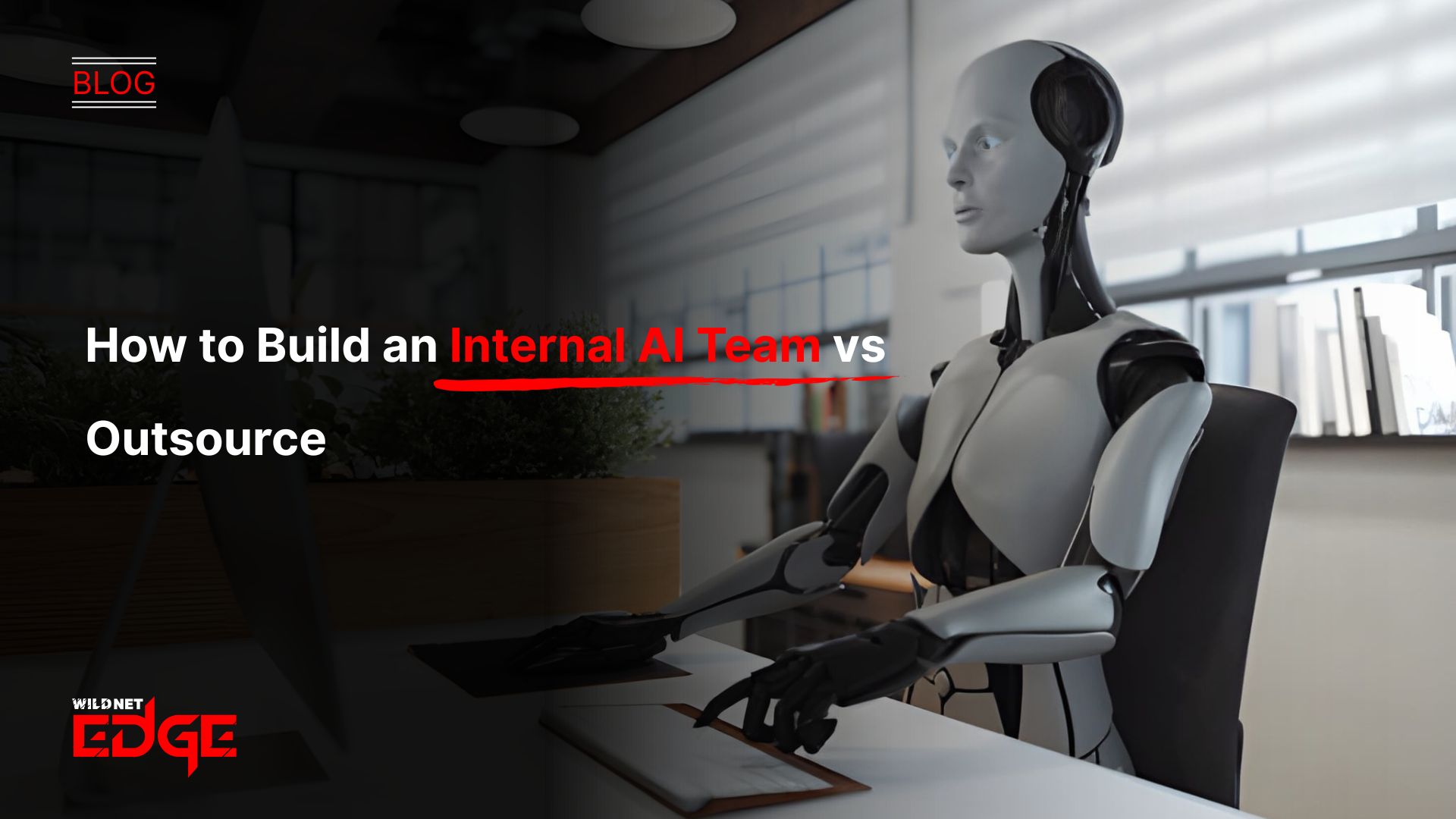TL;DR
This article examines the strategic choice between building an in-house AI team and outsourcing AI development. It explains that the hire AI developers vs outsourcing decision depends on goals, budget, and timelines. In-house teams offer control and alignment but come with high recruitment costs and slower setup, while outsourcing provides instant access to expertise and faster delivery at lower upfront costs. The guide compares both models across cost, speed, control, and expertise to help leaders choose the best fit for their AI initiatives.
As artificial intelligence moves from a niche technology to a core business capability, a critical question arises for leadership: How do we acquire the necessary talent? Do we invest in building a dedicated internal team, or do we partner with external experts? The decision of whether to hire AI developers vs outsourcing is a complex one with significant implications for your budget, timeline, and long-term strategic control. Understanding the tradeoffs in the build vs buy AI team equation is essential for crafting a successful AI journey.
Understanding the Two Primary Models
Let’s define the approaches clearly:
- Building an In-House AI Team: The process consists of sourcing, selecting, teaching, and supervising permanent personnel, comprising data scientists, machine learning engineers, AI architects, and MLOps specialists, who will be thoroughly integrated into your organization. A well-defined in-house AI talent strategy will be put in place.
- Outsourcing AI Development: The approach includes the engagement of a specialized external agency or firm to take over certain AI initiatives or support the AI department constantly. This can be anything from adding the outsourced AI development team’s personnel to completely managed project delivery by the team working with the client.
The Core Tradeoffs: Hire AI Developers vs Outsourcing
The “right” choice depends on how your business prioritizes several key factors.
1. Cost Structure and Investment
- In-House: Very high upfront investment (recruitment can cost 20-30% of first-year salaries for scarce talent). High ongoing fixed costs (salaries, benefits, tools, training). Potential for long-term cost efficiency if utilization is consistently high.
- Outsourcing: Lower upfront costs. Typically variable costs based on project scope or resources used (Time & Materials or Fixed Price). Often provides significant initial cost savings, especially with offshore partners. Requires careful scope management to control costs.
2. Speed to Execution
- In-House: Slow to start. Finding, attracting, and onboarding top AI talent can take 6-12 months or longer before a team is fully productive.
- Outsourcing: Much faster ramp-up. An established agency has vetted experts ready to start within weeks, dramatically accelerating project kickoff and time-to-market. This speed is often crucial for gaining an early advantage.
3. Control and Integration
- In-House: Maximum direct control over priorities, processes, and team culture. Deep integration with other business units and proprietary knowledge. Complete ownership of IP development practices.
- Outsourcing: Less direct control; you manage the vendor relationship and outcomes, not the day-to-day tasks. Requires strong communication, clear contracts, and trust in the vendor’s process. IP ownership must be clearly defined contractually.
4. Access to Expertise and Innovation
- In-House: Expertise is limited to the individuals you can successfully hire and retain. Keeping up with the rapidly evolving AI landscape requires continuous investment in training.
- Outsourcing: Immediate access to a diverse pool of specialists with experience across various AI domains (NLP, computer vision, predictive analytics) and industries. Reputable agencies are constantly investing in R&D and training. Partnering with an AI development company services provider can inject cutting-edge knowledge.
Building vs Buying an AI Team: A Summary
| Factor | In-House AI Team | Outsourced AI Team |
| Initial Cost | Very High | Moderate to Low |
| Ongoing Cost | High Fixed | Variable / Predictable (Project-based) |
| Speed to Start | Slow (6-12+ months) | Fast (Weeks) |
| Control | High Direct | Moderate Managed |
| Expertise Access | Limited by Hiring | High (Diverse Specialists) |
| Scalability | Slow / Difficult | Fast / Easy (Flexibility) |
| Knowledge Ret. | High (Internal) | Requires Deliberate Transfer |
| Management | High Internal Overhead | Lower Internal Overhead (Vendor Manages) |
Strategic Considerations for Your In-House AI Talent Strategy
If you choose to build internally, consider:
- Start Small and Focused: Begin with a small, core team focused on a high-impact initial project.
- Executive Sponsorship: Strong support from leadership is crucial for securing budget and driving cultural change.
- Define Clear Roles: AI requires diverse roles beyond just data scientists (e.g., data engineers, ML engineers, AI product managers).
- Invest in Training: The AI field evolves rapidly; continuous learning is essential.
- Build vs. Integrate: Decide which AI components are core IP to build versus leveraging third-party APIs or platforms. This often requires sophisticated custom software development for AI.
Making the Choice: Which Model Fits When?
- Choose In-House When: AI is absolutely core to your long-term competitive advantage, you have significant long-term funding, data sensitivity requires maximum control, and you need deep integration with proprietary systems.
- Choose Outsourcing When: Speed to market is critical (especially for an MVP), you lack in-house expertise, the project has a defined scope, you need specialized skills for a specific duration, or you want budget predictability. This is common for initial projects or augmenting teams for efforts like startup SaaS / product development.
- Consider Hybrid: Leverage outsourcing for initial projects or specialized tasks while gradually building a core internal team. Use staff augmentation to fill temporary gaps.
Real-World Scenarios
Case Study 1: A Startup Prioritizing Speed (Outsourcing)
- The Challenge: A seed-stage startup needed to launch an AI-powered recommendation engine MVP within 6 months but had no AI talent.
- The Decision: They opted for outsourcing AI development team. They partnered with an agency that provided a full team to build and launch the MVP quickly.
- The Outcome: The MVP launched on time, validating the core concept and enabling them to raise a Series A. They later used that funding to begin building a small internal team while retaining the agency for specialized modules.
Case Study 2: An Enterprise Building Core IP (In-House)
- The Challenge: A large insurance company decided that AI-driven risk assessment was fundamental to their future. They needed deep, long-term expertise integrated with their actuarial teams.
- The Decision: They committed to a multi-year in-house AI talent strategy, investing heavily in hiring top data scientists and ML engineers and building internal training programs. They still occasionally used outsourcing for non-core components. This involved significant internal work on projects akin to enterprise app development partner collaborations.
- The Outcome: After a significant initial investment and ramp-up time, they developed proprietary risk models that provided a substantial competitive advantage and became a core part of their intellectual property.
Technology Stack Considerations
Your staffing model may influence tech stack choices (e.g., choosing technologies where talent is more readily available if hiring internally), but core AI tools remain similar:
- AI/ML Frameworks: TensorFlow, PyTorch, Scikit-learn
- Cloud AI Platforms: AWS SageMaker, Azure Machine Learning, Google AI Platform
- Programming Languages: Python, R
Conclusion
The decision to hire AI developers vs outsourcing AI developers is not a one-size-fits-all solution. Establishing an in-house AI talent strategy allows for thorough integration and control, but it also demands a large investment of time and money. On the other hand, an outsourced AI development team brings about speed and specialized knowledge, which is frequently less expensive for the short term. Your company’s strategic objectives, urgency, budget, and long-term vision will determine the best choice for you. In many cases, a hybrid model that uses outside partners while deliberately creating internal capacity has the best chance of achieving a sustained AI-driven success.
Ready to define the right AI talent strategy for your business? At Wildnet Edge, our AI-first approach provides flexibility. We offer expert AI development services through various models, ensuring you have the right team structure to achieve your goals efficiently and effectively.
FAQs
Initially, outsourcing is almost always cheaper. Over 3 years, the calculation becomes complex. A fully utilized, highly efficient in-house team might become cheaper than a long-term, large-scale outsourcing retainer. However, factoring in recruitment costs, training, and potential underutilization often keeps outsourcing competitive, especially for variable needs.
Insist on thorough documentation, regular knowledge-sharing sessions, and joint code reviews. Ensure your contract clearly states you own the IP and source code. Consider having at least one internal technical person work closely with the outsourced team to absorb knowledge.
Not necessarily, if you choose the right partner and establish clear processes. Reputable agencies have mature QA processes. Define clear quality metrics, conduct regular code reviews (potentially with an internal lead), and ensure robust testing protocols are part of the contract.
Outsourcing is almost always significantly faster for launching an MVP. An established agency can start development within weeks, whereas hiring even one skilled AI engineer can take months.
Both models can support iteration. A dedicated in-house team allows for immediate pivots. A good outsourced partner working under an agile contract (like Time & Materials or a retainer) can also iterate very quickly based on your feedback during regular sprint cycles.
Not necessarily the only option, but often the preferred long-term goal. You could strategically outsource initial phases or specific complex components while simultaneously building your core internal team, eventually transitioning full ownership.
Consider:
* Urgency: High urgency favors outsourcing.
* Budget: Limited upfront capital favors outsourcing.
* Internal Expertise: Lack of expertise favors outsourcing.
* Control Needs: High need for direct control favors in-house.
* Long-Term Strategy: Is AI core IP? Favors eventual in-house.

Nitin Agarwal is a veteran in custom software development. He is fascinated by how software can turn ideas into real-world solutions. With extensive experience designing scalable and efficient systems, he focuses on creating software that delivers tangible results. Nitin enjoys exploring emerging technologies, taking on challenging projects, and mentoring teams to bring ideas to life. He believes that good software is not just about code; it’s about understanding problems and creating value for users. For him, great software combines thoughtful design, clever engineering, and a clear understanding of the problems it’s meant to solve.
 sales@wildnetedge.com
sales@wildnetedge.com +1 (212) 901 8616
+1 (212) 901 8616 +1 (437) 225-7733
+1 (437) 225-7733































